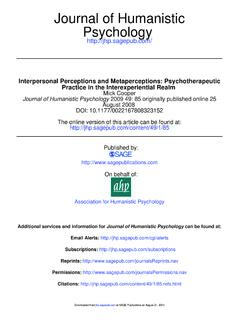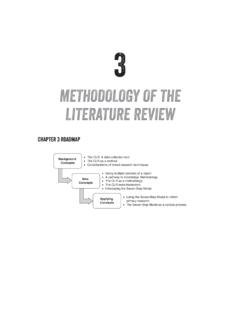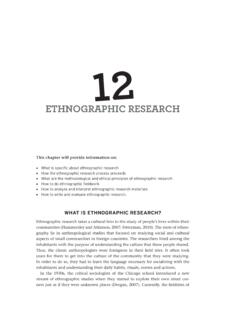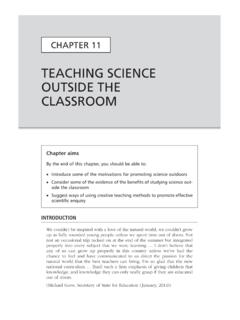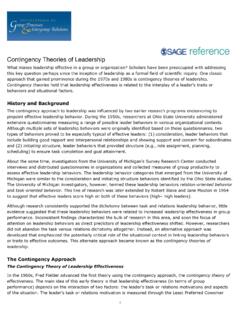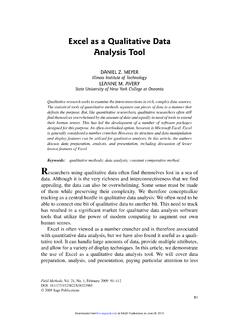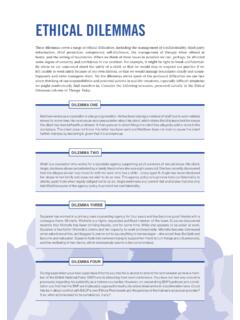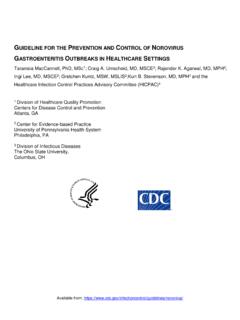Transcription of A Sample Quantitative Thesis Proposal
1 A Sample Quantitative Thesis Proposal Prepared by Mary Hayes NOTE: This Proposal is included in the ancillary materials of Research Design with permission of the author. If you would like to learn more about this research project, you can examine the following Thesis that resulted from this work: Hayes, M. M. (2007). Design and analysis of the student strengths index (SSI) for nontraditional graduate students. Unpublished master's Thesis . University of Nebraska, Lincoln, NE. Design and Analysis 1. Running Head: DESIGN AND ANALYSIS OF THE STUDENT STRENGTHS INDEX. (SSI). FOR NONTRADITIONAL GRADUATE STUDENTS. DESIGN AND ANALYSIS OF THE STUDENT STRENGTHS INDEX (SSI). FOR NONTRADITIONAL GRADUATE STUDENTS. Mary Hayes University of Nebraska Lincoln April 28th, 2007. 1. Design and Analysis 2. I. Introduction Background of the study Introduction Admission committees at graduate schools across the United States are charged with the task of deciding who to admit into graduate programs.
2 These decisions are often based on readily available measures used to predict the likelihood of student success including standardized examinations such as the Graduate Records Examination (GRE). and measures of past performance such as the Undergraduate Grade-Point Average (UGPA). Sternberg and Williams (1997) examined the uses of the GRE to admit students to graduate school. Some schools use the GRE score as a cut score to even be considered for admission or provide an average GRE in their admission materials (p. 631). While the use of these measures is common practice, it is not clear whether these measures can accurately predict student success in all graduate student applicants. When considering populations of graduate students described as nontraditional, often over 30 years of age or several years removed from their baccalaureate degree, these measures take on increased importance (Hartle, Braratz, & Clark, 1983).
3 This study examined the use of a non- cognitive assessment tool to measure student's strengths which can be used as an additional factor for admission committees when considering admitting nontraditional graduate students. Statement of Problem The current admission criteria vary from university to university. Schools often require a student to take a standardized exam such as the Graduate Records Examination (GRE) which can be weighted heavily in the overall admission decision (Kuncel, Hezlett 2. Design and Analysis 3. & Ones, 2001). Standardized examinations are typically designed for traditional-aged students, who tend to perform better than nontraditional aged test-takers. Lindle and Rinehart (1998) state the GRE was designed for traditional' graduate students, those who pursue advanced studies full time immediately or shortly after attaining their baccalaureates ( ). Other studies have found that older students score significantly lower particularly on Quantitative measures associated with the GRE (Clark, 1984.)
4 Hartle, Braratz, & Clark, 1983). If admission or selection decisions are based primarily on measures such as the GRE alone, the potential impact of adverse decisions is enormous because an estimated of the 2,637,000 students entering graduate school in 2003 were over the age of 30 (Digest of Educational Statistics, 2004). Most schools use multiple factors to consider applicants for admission. However, schools have a limited amount of resources to admit students each year. There are more applicants than positions to be filed. The number of applicants to admitted students varies by department or school; at Yale University in the Comparative Literature department reports a 10:1. ratio for applicants to acceptance ( (November 15, 2007)). There is no explicit minimum stated; however, they make note that the scores of those admitted tend to be high to very high. The ratio for applicants to admission for the Department of Planning Policy and design at University of California- irvine for the PhD program is 5:1 ( , (November 15, 2007)).
5 The minimum GRE combined for UC- irvine is 1000; the website states that applicants falling below the minimum on either standard should exhibit compensatory strengths in other areas. At the University of Nebraska-Lincoln in the Educational Psychology department the admit ratio varies by specialization, 2:1 for Cognition, Learning and Development (CLD); :1 for Quantitative Qualitative and Psychometric 3. Design and Analysis 4. Methods (QQPM); 5:1 for Counseling Psychology, and 4:1 for School Psychology. ( Burgess, Admission Administrator, personal communication, November 20, 2007). There is no minimum for the department of Educational Psychology stated publicly. As the number of applications increases the more selective the universities and colleges tend to be in terms of cut scores for the GRE. Schools also require the applicants to provide other information such as letters of recommendation and a personal statement of goals.
6 The letters of recommendations receive high importance ratings to many graduate programs in psychology (Fauber, 2006). Applicants tend to choose individuals that they know will provide stellar recommendations. Therefore, these measures are subjective in nature and may not provide an accurate picture of the student's success characteristics in graduate school. Significance of study Education is an important investment in one's future. For the past two decades the influx on nontraditional students into post secondary education has a dramatically increased. These students are older and have many responsibilities outside of their education. They take classes online, on weekends and evenings. They are aware of the benefit that an education can give to them. They sacrifice a great deal in order to get the education they know they need. They understand that in order to succeed in their chosen profession they need further education (Beitler, 1997).
7 This is one of the reasons that older students return to school after a long absence. One of the major obstacles for nontraditional students is the GRE which can be biased against these students (Murray, 1998). These students are often denied admission into graduate school based on scores that may not be a true reflection of their ability to succeed in graduate school. 4. Design and Analysis 5. Need for Study Research exploring the use of measures such as standardized examinations and the UGPA to predict performance in graduate school is plentiful (Holt, Bleckmann &. Zitzmann 2006, Nelson & Nelson, 1995, Sacks, 1997, Sacks, 2003). Sacks (2003) stated that the use of standardized tests blinds us to what's real about individual students and their real-world skills, academic or otherwise (p. 20). Unfortunately, despite the often- reported shortcomings of these measures, there is relatively less research exploring alternative selection practices for the nontraditional graduate program applicant.
8 The nontraditional student tends to be achievement oriented, highly motivated, and relatively independent (Cross, 1980). Others describe them as meta-motivated and goal oriented (Davis & Henry, 1997). Davis and Henry (1997) state nontraditional students have special needs and capacities that distinguish them from traditional students (p. 3). Failure to consider factors such as motivation and goal orientation could lead to the exclusion of many potential nontraditional graduate students who could have been successful. This is an area where the current research falls short. There is currently no assessment available that students can take to demonstrate objectively to graduate admissions committees the extent of motivation, interaction, cognition and execution they possess. If these could be measured, admission into graduate school could be based on multiple factors above and beyond the traditional cognitive methods alone.
9 The purpose of the study was to design and validate a tool called the Student Strengths Index (SSI) to assess motivation, interaction, execution and cognition and create a success profile of the nontraditional graduate student. Specifically, this study addressed the following research questions: 5. Design and Analysis 6. 1. Can a non-cognitive instrument to measure motivation and other competencies be developed to predict success of the nontraditional student in graduate school in comparison to the traditional means? 2. Does the motivation, interaction, execution and cognition of nontraditional students predict success in graduate school? Assessments such as the SSI are used everyday in the business arena to help predict success of individuals in sales, management and other professional careers. The SSI was adapted from a tool originally created by TalentMine LLC called the TalentMine1 Index (TMI). This tool is used to design strengths profiles to select individuals who will succeed in the position they are applying.
10 If a profile could be developed of a successful nontraditional graduate student then this information could be used in conjunction with the GRE and other measures as a selection tool for admission committees to select individuals who will succeed in graduate education. Hypotheses The following are the primary hypotheses of this project. 1. Nontraditional students' motivation, interaction, execution and cognition are contributing factors in their success in graduate school. 2. There are no differences in non-traditional students' motivation, interaction, execution and cognition based on gender or degree. 3. The Student Strengths Index (SSI) and GRE composite score are significant predictors of success in graduate school. 1. TalentMine Index is the intellectual property of TalentMine LLC, therefore the instrument is not included. 6. Design and Analysis 7. Limitations The Sample consisted of University of Nebraska Lincoln (UNL) graduate students.
